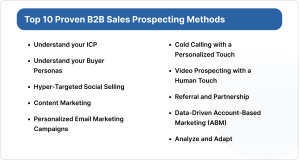Do you think that prospecting is the most difficult part of your sales process? Well, you’re not alone. Over 40% of salespeople agree that B2B prospecting is the most challenging part of the sales process.
But fear not – this guide will walk you through some of the best proven B2B sales prospecting methods that you can leverage for successful prospecting.
What is B2B Prospecting?
B2B prospecting is the process of identifying potential business customers (prospects), nurturing them, and ultimately converting them into paying customers. It is a crucial step in the customer acquisition journey. Sales and marketing professionals use a variety of different B2B prospecting methods to fill the sales funnel with qualified leads.
Why is B2B Prospecting Important?

Here are some key reasons why B2B prospecting is important:
1. Sales Pipeline Development:
Without a steady flow of qualified leads entering your pipeline, your sales team will struggle to close deals and drive revenue. Effective Prospecting ensures you have a continuous stream of potential customers to nurture and turn them into paying clients.
2. Identifies New Customer Segments:
Through prospecting, you can explore new markets and customer segments and ultimately, expand your reach and potential client base. This can help you unlock valuable opportunities and diversify your revenue streams.
3. Builds Relationships:
B2B sales thrive on long-term relationships with customers. Prospecting lets you proactively engage with potential clients, build trust, and establish trust early on. This lays the strong foundation for strong customer partnerships.
4. Competitive Edge:
In today’s highly competitive B2B market landscape, effective prospecting can give you a competitive edge. Identifying and reaching potential clients before rivals ensures early engagement and relationship building.
5. Optimized Resource Allocation:
Targeted prospecting helps you allocate resources more efficiently. By focusing efforts on high-potential leads and industries, you can optimize your marketing and sales resources for maximum impact.
As you can see, B2B prospecting is not just about acquiring new clients but it’s a strategic process to drive revenue, build long-term relationships, and fuel business growth. In fact, it’s the cornerstone of successful B2B sales, ensuring you have a healthy pipeline of qualified leads for your business.
Top 3 Challenges of B2B Prospecting (and How to Address Them)
B2B prospecting comes with its own set of challenges. Here’s a look at some of the top obstacles sales and marketing experts face when it comes to B2B sales prospecting and strategies to effectively tackle them:
1. Identifying the Right Prospects
The first step of B2B prospecting is also one of its biggest challenges i.e. finding qualified prospects. This can be a time-consuming, research-intensive process. The problem? An Ideal customer profile (ICP) is often vague or poorly defined, which leads to wasted efforts pursuing prospects who hold no real promise.
Solution: Clearly define your ICP by conducting thorough market research, analyzing your existing customer base, and exploring industry trends to pinpoint common characteristics. You can also collaborate closely with sales and marketing teams to build a comprehensive profile that includes industry specifics, company size, pain points, and purchasing behaviors. Take advantage of advanced analytics B2B prospecting tools to analyze historical data and generate a more precise ICP. Most importantly, regularly update the ICP based on evolving market trends and customer insights.
2. Understanding the Buyer’s Journey Stages
Another challenge in B2B prospecting involves comprehending the intricacies of the buyer’s journey, its distinct stages and the specific pain points that surface at each stage. Businesses often struggle with the challenge of discerning the optimal timing and strategy to engage prospects at various stages. Additionally, tailoring strategies to align with the distinctive demands and expectations prevalent during each stage of the journey poses a complex challenge.
Solution: Implement customer journey mapping i.e. define the key stages of your buyer’s journey (awareness, consideration, decision) and collaborate with sales, marketing, and customer support teams to identify touchpoints and pain points at each stage. This will help you tailor your messaging and content to each stage.
3. Aligning Sales and Marketing Teams
Achieving seamless collaboration between sales and marketing teams with unique goals and objectives presents a significant challenge in B2B prospecting. The lack of alignment can lead to disjointed prospecting efforts, hindering the overall effectiveness of the B2B sales prospecting strategy.
Solution: Implement shared goals and metrics to align efforts and foster a sense of shared responsibility. Leverage technology, such as integrated CRM systems, to facilitate seamless data sharing between the two departments, ensuring a unified approach to B2B prospecting.
Top 10 Proven B2B Sales Prospecting Methods to Elevate Your Overall Outreach Game

Without adding further, let’s now get straight into the B2B prospecting methods you can explore to take your outreach game to the next level.
1. Understand your ICP – Inside and Out
To lay a robust foundation for your B2B prospecting efforts, it’s important to delve deep into understanding your Ideal Customer Profile (ICP). This involves not just defining surface-level characteristics such as demographics and industry. but gaining a nuanced understanding of their pain points, challenges, goals and aspirations. By comprehensively grasping your ICP, you can tailor your sales prospecting methods to align seamlessly with the needs of your most valuable prospects.
2. Understand your Buyer Personas – Inside and Out
In conjunction with your ICP, focus on creating detailed buyer personas. Again, go beyond demographic data and explore their motivations, pain points, preferred communication channels, and the factors influencing their purchasing decisions. This holistic understanding enables you to create personalized and compelling outreach strategies.
Here are some tips to gain a comprehensive understanding of your buyer personas inside and out:
- Engage in one-on-one interviews with existing clients to understand their decision-making processes.
- Gather insights into their goals, preferences, and the factors that influenced their choice of your product or service.
- Conduct surveys to gather quantitative data on buyer behaviors and preferences.
- Take advantage of your Customer Relationship Management (CRM) system and sales data to identify patterns in buyer behaviors.
- Map out the entire buyer’s journey for each persona to identify decision-making criteria at each stage.
3. Focus on Hyper-Targeted Social Selling
In today’s digital era, social selling has become an effective method for B2B prospecting. It is a sales strategy that involves taking advantage of the right social media channels to find, engage, and nurture potential customers.
In fact, studies reveal that a whopping 92% of B2B buyers are willing to connect with sales professionals who are known as industry thought leaders on social media channels.
When it comes to social selling, forget about generic messages! For example, leverage LinkedIn Sales Navigator to identify specific individuals that match your ICP, connect with them based on shared connections or industry knowledge, and offer valuable insights instead of just sales pitches.
4. Leverage Content Marketing
Become a thought leader in your industry by creating valuable and relevant content. Develop content that addresses the pain points of your target audience, showcases your industry expertise, and provides actionable insights. Whether through blogs, whitepapers, webinars or ebooks, strategic content marketing positions your brand as a thought leader and attracts prospects seeking solutions.
5. Implement Personalized Email Marketing Campaigns
Email marketing remains a cornerstone of B2B sales prospecting when done right. In fact, a study reveals that 81% of SMBs still rely on email marketing as their primary customer acquisition channel, and 80% for customer retention.
Implement personalized email campaigns that resonate with your target audience. Segmented email campaigns drive 30% more opens and 50% more click-throughs than untargeted ones.
So, tailor your messaging based on the prospect’s industry, role, and pain points. With the help of automation tools, you can schedule follow-ups and ensure timely, relevant communication throughout the buyer’s journey.
6. Cold Calling with a Personalized Touch
While the landscape of B2B sales prospecting has evolved, cold calling remains an invaluable method when approached with personalization. In fact, 27% of sales teams consider the phone as the best single channel to book meetings. Moreover, 57% of C-level and VP buyers across different industries prefer the phone call,
So, forget about the robotic scripts! Research your prospects thoroughly before making contact and tailor your approach to their individual interests and challenges. A personalized touch in cold calling can increase the likelihood of engagement.
7. Video Prospecting with a Human Touch
Do you want to stand out from the text-heavy inbox? If yes, then use video for product demonstrations, personalized messages, or to share success stories, fostering a deeper connection with potential clients.
Companies using video witnessed 20% higher conversion rates during the first 30 days after using it as part of their B2B prospecting methods versus those without videography in place.
8. Leverage Referral and Partnership Power
Did you know that 71% of B2B companies report higher conversion rates from referrals than other customers? Leverage your existing network and industry partnerships. Encourage satisfied customers to refer your services/products to their peers. Additionally, you can explore strategic partnerships with complementary businesses to tap into shared audiences.. Leveraging trusted networks can open doors to high-quality leads and build credibility with potential customers.
9. Data-Driven Account-Based Marketing (ABM)
Rather than wasting efforts on irrelevant accounts, focus your resources on high-value targets. Utilize data analytics B2B prospecting tools to identify high-potential accounts and personalize your marketing strategies accordingly. This targeted approach can lead to shorter sales cycles and larger deals.
10. Analyze and Adapt
B2B sales Prospecting is an iterative process that demands continuous analysis and adaptation. Regularly assess the performance of your B2B prospecting methods, analyze data, and gather feedback. Use these insights to refine your strategies and try new things.
Elevate Your B2B Sales Prospecting Game with InfoStride
As a provider of B2B-focused digital marketing services, InfoStride is here to help propel your prospecting endeavors to new heights. This will help you secure qualified leads for your sales prospecting initiatives, bringing you one step closer to successfully closing more deals.
Our experts will work closely with your team to refine and tailor your ICP. This ensures that your prospecting efforts are aligned with the specific needs and characteristics of the potential clients who are most likely to benefit from your offerings.
By integrating advanced technologies, data-driven insights, and industry expertise, InfoStride positions itself as not just a service provider but a strategic partner for your sales and marketing success.
Get in touch with us to get started today.
FAQs
1. What are the key elements of a successful B2B sales prospecting strategy?
A successful B2B sales prospecting strategy encompasses defining target customer profiles, leveraging numerous prospecting methods, utilizing technology, personalizing outreach efforts, and continually refining the approach based on feedback and results.
2. How can businesses measure the success of their B2B sales prospecting efforts?
Measuring the success of your B2B sales prospecting efforts is pivotal to optimizing your strategy. Here are some key metrics to track: conversion rates, lead quality, engagement metrics, and revenue generated from prospects. Regularly analyze these metrics to refine your strategies.
3. What are some emerging trends in B2B sales prospecting for the future?
Emerging trends in B2B sales prospecting include the increased use of artificial intelligence (AI), predictive analytics for lead scoring, video marketing, and a focus on account-based marketing.
4. Can businesses combine inbound and outbound strategies in B2B sales prospecting?
Indeed, yes. You can effectively combine inbound (attracting leads via content marketing and online presence) and outbound (proactively reaching out to potential clients) methods to build a comprehensive and dynamic B2B sales prospecting approach.
5. What is the best prospecting method for B2B?
There’s no single “best” B2B prospecting method because the effectiveness depends on numerous factors, such as your niche, target audience, products/ services being offered, and unique selling proposition. A successful prospecting strategy for B2B often involves a combination of various techniques, such as email outreach, data-driven cold calling, content marketing and social selling.






